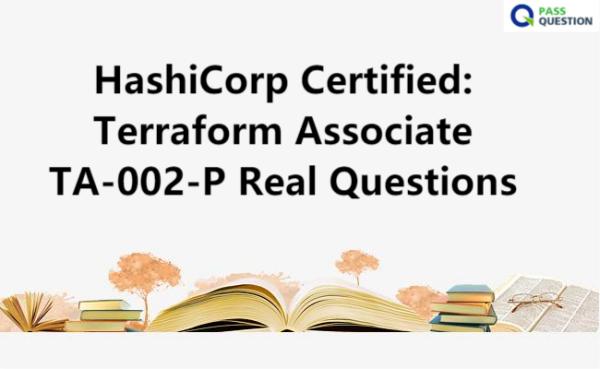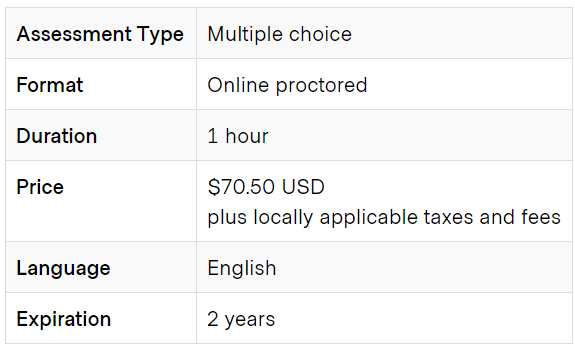HashiCorp Certified: Terraform Associate TA-002-P Real Questions
If you want to clear HashiCorp Certified: Terraform Associate exam,PassQuestion provides up-to-date actual HashiCorp Certified: Terraform Associate TA-002-P Real Questions which will help you to pass your exam in first attempt.You can easily download the TA-002-P Questions Answers for the preparation of HashiCorp Certified: Terraform Associate Exam and it is especially designed for HashiCorp TA-002-P exam and PassQuestion prepared HashiCorp Certified: Terraform Associate TA-002-P Real Questions that would be asked in the real TA-002-P exam.

HashiCorp Certified: Terraform Associate
The Terraform Associate certification is for Cloud Engineers specializing in operations, IT, or development who know the basic concepts and skills associated with open source HashiCorp Terraform. Candidates will be best prepared for this exam if they have professional experience using Terraform in production, but performing the exam objectives in a personal demo environment may also be sufficient. This person understands which enterprise features exist and what can and cannot be done using the open source offering.
Exam Details

Exam Objectives
1 Understand infrastructure as code (IaC) concepts
- 1a Explain what IaC is
- 1b Describe advantages of IaC patterns
2 Understand Terraform's purpose (vs other IaC)
- 2a Explain multi-cloud and provider-agnostic benefits
- 2b Explain the benefits of state
3 Understand Terraform basics
- 3a Handle Terraform and provider installation and versioning
- 3b Describe plugin based architecture
- 3c Demonstrate using multiple providers
- 3d Describe how Terraform finds and fetches providers
- 3e Explain when to use and not use provisioners and when to use local-exec or remote-exec
4 Use the Terraform CLI (outside of core workflow)
- 4a Given a scenario: choose when to use terraform fmt to format code
- 4b Given a scenario: choose when to use terraform taint to taint Terraform resources
- 4c Given a scenario: choose when to use terraform import to import existing infrastructure into your Terraform state
- 4d Given a scenario: choose when to use terraform workspace to create workspaces
- 4e Given a scenario: choose when to use terraform state to view Terraform state
- 4f Given a scenario: choose when to enable verbose logging and what the outcome/value is
5 Interact with Terraform modules
- 5a Contrast module source options
- 5b Interact with module inputs and outputs
- 5c Describe variable scope within modules/child modules
- 5d Discover modules from the public Terraform Module Registry
- 5e Defining module version
6 Navigate Terraform workflow
- 6a Describe Terraform workflow ( Write -> Plan -> Create )
- 6b Initialize a Terraform working directory (terraform init)
- 6c Validate a Terraform configuration (terraform validate)
- 6d Generate and review an execution plan for Terraform (terraform plan)
- 6e Execute changes to infrastructure with Terraform (terraform apply)
- 6f Destroy Terraform managed infrastructure (terraform destroy)
7 Implement and maintain state
- 7a Describe default local backend
- 7b Outline state locking
- 7c Handle backend authentication methods
- 7d Describe remote state storage mechanisms and supported standard backends
- 7e Describe effect of Terraform refresh on state
- 7f Describe backend block in configuration and best practices for partial configurations
- 7g Understand secret management in state files
8 Read, generate, and modify configuration
- 8a Demonstrate use of variables and outputs
- 8b Describe secure secret injection best practice
- 8c Understand the use of collection and structural types
- 8d Create and differentiate resource and data configuration
- 8e Use resource addressing and resource parameters to connect resources together
- 8f Use Terraform built-in functions to write configuration
- 8g Configure resource using a dynamic block
- 8h Describe built-in dependency management (order of execution based)
9 Understand Terraform Cloud and Enterprise capabilities
- 9a Describe the benefits of Sentinel, registry, and workspaces
- 9b Differentiate OSS and TFE workspaces
- 9c Summarize features of Terraform Cloud
View Online HashiCorp Certified: Terraform Associate TA-002-P Free Questions
Workspaces provide identical functionality in the open-source, Terraform Cloud, and Enterprise versions of Terraform.
A.True
B.False
Answer : B
Which of the following commands will launch the Interactive console for Terraform interpolations?
A.terraform console
B.terraform cli
C.terraform
D.terraform cmdline
Answer : B
During a terraform plan, a resource is successfully created but eventually fails during provisioning. What happens to the resource?
A.Terraform attempts to provision the resource up to three times before exiting with an error
B.the terraform plan is rolled back and all provisioned resources are removed
C.it is automatically deleted
D.the resource is marked as tainted
Answer : D
Which of the following is not a valid Terraform string function?
A.replace
B.format
C.join
D.tostring
Answer : D
Which of the following statements best describes the Terraform list(...) type?
A.a collection of values where each is identified by a string label.
B.a sequence of values identified by consecutive whole numbers starting with zero.
C.a collection of unique values that do not have any secondary identifiers or ordering.
D.a collection of named attributes that each have their own type.
Answer : B
When using the Terraform provider for Vault, the tight integration between these HashiCorp tools provides the ability to mask secrets in the terraform plan and state files.
A.False
B.True
Answer : A
- TOP 50 Exam Questions
-
Exam
All copyrights reserved 2026 PassQuestion NETWORK CO.,LIMITED. All Rights Reserved.

